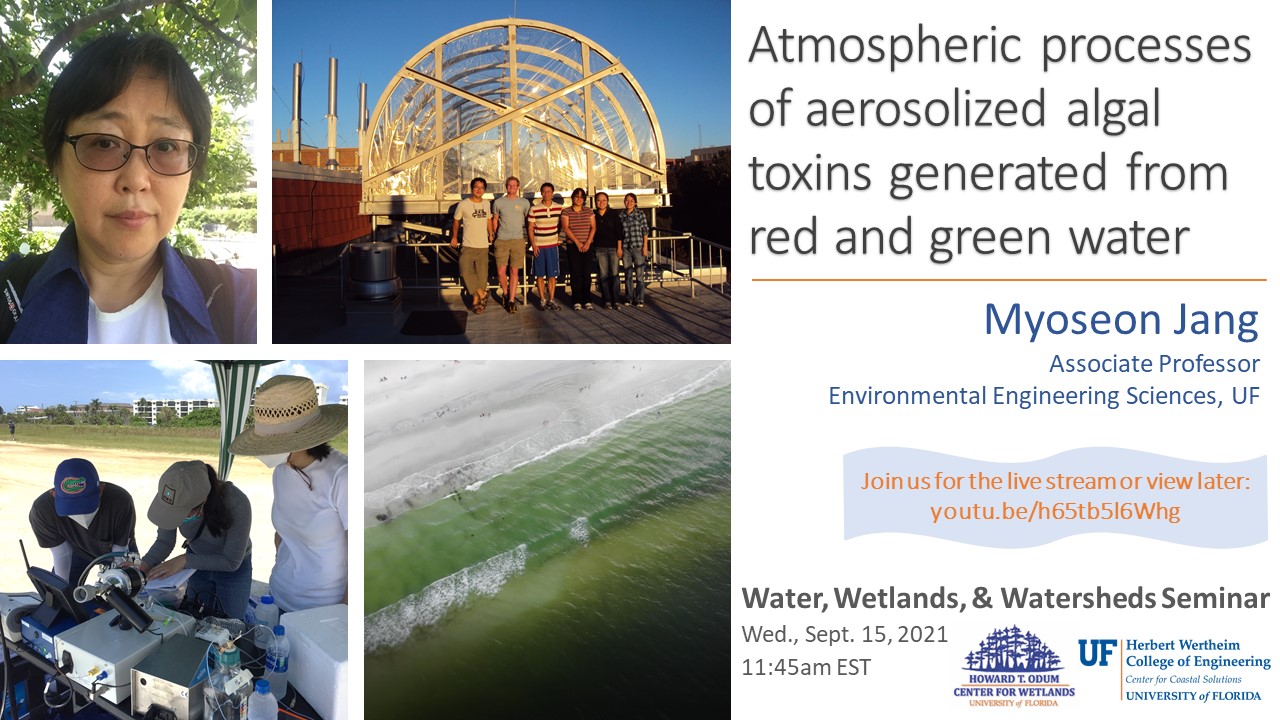September 15, 2021

Atmospheric processes of aerosolized algal toxins generated from red and green water
Myoseon Jang, Associate Professor, Environmental Engineering Sciences, UF
Join us for the live stream Sept 15, 11:45am EST: youtu.be/h65tb5l6Whg
(Please visit our youtube channel main page for the stream is there are any issues with the direct link.)
ABSTRACT
Florida, once a sunny paradise that attracted new residents with its welcoming tax rate and high quality of life, suffers for its rapid population growth and climate changes. At the top of the list is the environmental catastrophe that resulted from outbreaks of toxic red tide (Karenia brevis) in oceans and blue-green (cyanobacterial) algae in fresh water. Sea spray aerosol (SSA) generated directly above red tide events in the Florida Gulf Coast can contain high concentrations of algal toxins such as brevetoxin (BTx). Fresh water is also produced by breaking waves and bursting bubbles in lakes and estuaries, and can contain toxins such as microcystins (MC) during cyanobacterial blooms.Exposure of both aerosolized BTx to coastal communities and aerosolized MC to residences close fresh water can result in significant respiratory irritation and increased hospitalizations. A fundamental question remains concerning the longevity of toxins associated with algal aerosol in ambient air. This study characterizes the environmental factors such as sunlight and atmospheric oxidants (e.g. ozone and OH radicals) on the lifetime of aerosolized algal toxins. Samples of seawater collected during red tide bloom in Manasota Key, Florida or samples from were nebulized into a large outdoor photochemical chamber (UF-APHOR) to mimic the atmospheric process of aerosolized red tide algal toxins. The cyanobacteria culture aliquot (Microcystis aeruginosa and Dolichospermum sp.) spiked with MC-LR was also nebulized into a large outdoor photochemical chamber. The aerosols are then atmospherically aged under various environmental conditions, such as in the presence or absence of sunlight, ozone, OH radicals, and organic matter. Aerosols were collected during the aging process using a Particle-to-Liquid Sampler. The aerosols’ toxin concentrations are measured using an enzyme-linked immunoabsorbent assay (ELISA) and liquid chromatography/mass spectrometry/mass spectrometry (LC-MS/MS) to assess the rate and extent of their degradation. Our studies showed that both BTx and MC-LR concentrations in algal aerosol decreased more rapidly in the presence of sunlight than in the absence of sunlight, suggesting that reactions with OH radicals contribute largely to the algal toxin degradation. Our nighttime chamber studies also showed that both BTx and MC-LR decayed by ozone. Overall, MC-LR of this study is more reactive to atmospheric oxidants than BTx. With 61.5 ppb ozone, the second order rate constant of ELISA-based MC-LR in Microcystis aeruginosa aerosol was about (3.91±0.17)´105 M-1s-1 (54-minute lifetime). In the similar condition, the BTx ozonolysis rate constant measured by ELISA was 5.74 ± 0.21 × 103 M-1 s-1 (2.35 hours lifetime). We conclude that under natural sunlight, algal toxins quickly decays via heterogeneous chemistry with atmospheric oxidants, but can still impact neighboring communities. Chamber data are used to obtain kinetic constants for the reaction of algal toxins with major atmospheric oxidants and apply to a development of a risk model to protect coastal communities from algal toxin exposure during harmful algae breaks.
Bio
Dr. Myoseon Jang is an associate professor of University of Florida. Jang has 28 years experiences in studies of atmospheric aerosol by developing models and chamber simulation. Jang discovered a new component of the kinetic mechanism behind the formation of atmospheric aerosol under varied environments (SO2, NOx and metrological conditions). Her efforts benefits research on climate forcing by measuring aerosol optical properties as well as pulmonary health via developments of in vitro exposure methods and discovery of toxicity mechanisms of numerous aerosols originating from red tide, cyanobacterial blooms, hydrocarbon oxidations, mineral dust, biomass burning, and automobile exhaust. Jang has placed a heavy emphasis on disseminating her work to the international community via international workshops, scholarships, research projects, and the development of educational programs.
Visit Dr. Jang’s Atmospheric Chemistry Lab.
POSTCARD
